Bereichsnavigation
Das Akkordeon

Spotlightausstellung im Musikinstrumenten-Museum
ab 22. Januar 2026
Das Akkordeon ist in vielen Stilrichtungen ein bekannter Akteur: in folkloristischer und populärer Musik, im Jazz und in Tanzmusik, sowie in zeitgenössischer Musik. Durch Yann Tiersens Soundtrack zum Film Die fabelhafte Welt der Amelie wurde sein Klang einem Millionenpublikum vertraut.
Die Töne erklingen durch frei schwingende Metallzungen. Der Balg zum Erzeugen des Luftstromes lässt das Instrument atmen, womit die Musik einen einzigartigen Charakter erhält. Entstanden ist das Akkordeon ab ca. 1820 gleichzeitig in Deutschland und Österreich. Mittlerweile gibt es zahlreiche Varianten. Gemeinsam ist ihnen, dass Einzeltöne über Knöpfe oder Tasten in der rechten Hand gespielt werden. Die Knöpfe in der linken Hand lassen ganze Akkorde erklingen.
Die Herstellung in großer Stückzahl erfolgte ab Mitte des 19. Jahrhunderts. Größere Betriebe montierten die Einzelteile, die oft von Gelegenheitsarbeitern zu Hause angefertigt wurden. Händler nahmen fertige Instrumente ab und versandten sie in die ganze Welt. Da sie robust und gut zu transportieren sind, erklangen sie bald in Konzert- und Tanzsälen, bei Volksfesten und zahlreichen weiteren Gelegenheiten.
The World of the Accordion
The instrument of the year 2026 is the accordion. It is a well-known protagonist in many musical styles: in folk and popular music, in jazz and dance music, as well as in contemporary compositions. Thanks to Yann Tiersen’s soundtrack for the movie Amélie, its sound became familiar to millions.
The tones are produced by vibrating metal reeds. The bellows, which generate the airflow, make the instrument breathe, giving the music a unique character. The accordion originated around 1820, simultaneously in Germany and Austria. Today, there are numerous variations. What they all have in common is that single notes are played with buttons or keys on the right hand, while the buttons on the left hand produce entire chords.
Production began in the mid-19th century. Larger workshops assembled the individual parts, which were often made by home-based workers. Dealers purchased the finished instruments and shipped them all over the world. Because accordions are sturdy and easy to transport, they soon resounded in concert and dance halls, at folk festivals, and on many other occasions.

